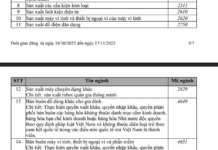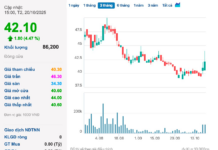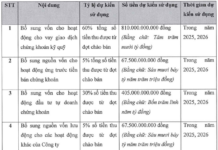Bank of America: Asia Currencies Outlook
In a recent report, Bank of America said it has “turned less constructive on Asian currencies.”
Several currencies are suffering as the U.S. Federal Reserve delays interest rate cuts and the U.S. dollar strengthens, particularly following the March 2024 U.S. CPI report.
Markets now see the Fed’s first rate cut pushed back to September 2024, with only two cuts priced in for the year.

Bank of America now has a negative outlook on the Vietnamese dong, Chinese yuan, South Korean won, Taiwan dollar, and Thai baht.
Meanwhile, currencies such as the Hong Kong dollar, Indonesian rupiah, Indian rupee, Malaysian ringgit, Philippine peso, and Singapore dollar are rated “neutral.”
USD/VND forecast at 25.700 by year-end
The Vietnamese dong is hovering around 25.450 per U.S. dollar, down nearly 5% since the start of the year.
Apart from the Fed’s dovish shift, the Vietnamese dong has been pressured by weakness in the real estate sector. These headwinds have fueled demand for the U.S. dollar and gold.
“We revise up our USD/VND forecasts to 25.600 by end-Q2 2024 and 25.700 by end-year,” BofA said in its report.
Similarly, the Thai baht is also impacted by geopolitical tensions via higher oil prices and freight costs. They forecast the Thai baht at 37 per U.S. dollar by the end of this year.
Chinese yuan
BofA expects the Chinese yuan to trade around 7.35 per U.S. dollar this quarter and then weaken to 7.45 per U.S. dollar in Q3-Q4 2024.
The bank expects the yuan’s depreciation to extend into the second half of 2024, as the Fed delays easing, disinflation widens the yield gap with the U.S., and the current account weakens on declining FDI. The Chinese yuan is currently trading around 7.24 per U.S. dollar.
South Korean won
The outlook for the Korean won has “deteriorated significantly” after the Fed pushed back its rate cut timeline and geopolitical risks emerged in the Middle East, according to BofA.
“YTD, we have seen impressive inflows into the South Korean equity market, but these flows have begun to reverse as global markets grapple with the twin risks from the Fed and the Middle East,” BofA economists wrote.
The won has dropped to an 18-month low of 1,389.5 per U.S. dollar. The governor of the Bank of Korea said the won’s moves have been “excessive” and will intervene if needed.
BofA economists believe the Korean currency is overvalued at 1,417 per U.S. dollar.
Taiwan dollar
BofA is also negative on the Taiwan dollar as outflows from the stock market accelerate and life insurers unwind non-deliverable forward (NDF) currency contracts. The Taiwan dollar is currently trading around 32.6 per U.S. dollar.
The bank made no mention of the Japanese yen. The Japanese currency is hovering near a 34-year low against the U.S. dollar. The yen has weakened past 150 per U.S. dollar since the Bank of Japan raised interest rates in March 2024.
Written by Vu Hao (via CNBC)





































